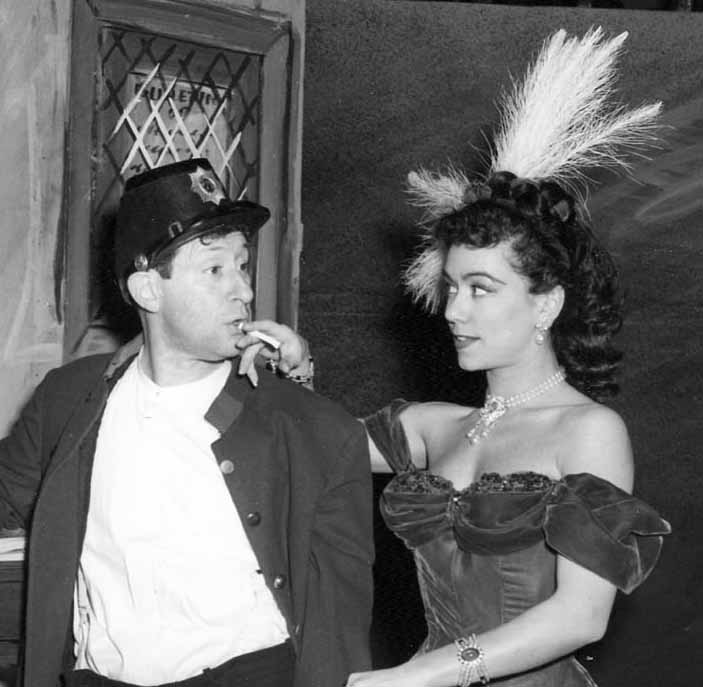Key Word Search
Multi-Field Search
Browse
Repertory Report
Performers Report
Contacts
Met Opera Website
New Production
Die Fledermaus
Metropolitan Opera House, Wed, December 20, 1950
Debut : Eugene Ormandy, Jack Gilford, Garson Kanin
In English
Die Fledermaus (11)
Johann Strauss II | Karl Haffner/Richard Genée
- Rosalinde
- Ljuba Welitsch
- Eisenstein
- Set Svanholm
- Adele
- Patrice Munsel
- Alfred
- Richard Tucker
- Prince Orlofsky
- Risë Stevens
- Dr. Falke
- John Brownlee
- Dr. Blind
- Paul Franke
- Frank
- Hugh Thompson
- Ida
- Nana Gollner
- Frosch
- Jack Gilford [Debut]
- Conductor
- Eugene Ormandy [Debut]
- Director
- Garson Kanin [Debut]
- Designer
- Rolf Gérard
- Choreographer
- Antony Tudor
Translation by Dietz, Kanin
The production was billed in the program as Fledermaus, retaining this title until its final appearance in 1967. Tudor did the choreography for the original staging, but his dances were replaced by new Solov choreography on March 3, 1951. Dietz translated the lyrics, Kanin the text.
Die Fledermaus received thirty-one performances this season.
Review 1:
Review of Olin Downes in The New York Times
STEALS THE SHOW
MUNSEL EXCELS IN 'FLEDERMAUS'
She Scores as Adele in New Version of Strauss Opera - Ormandy is Conductor
Debussy remarked that there is one music, which may be found in a waltz or a symphony. This was proved again last night when the Metropolitan Opera Association presented a new Americanized version of the operetta by Johann Strauss, "Fledermaus," staging the piece and performing it with a sufficiency of technical brilliancy and high spirits to delight a hilarious audience.
The new version of the libretto departs far from the Viennese original. It need not be compared with this for fineness of wit and dialogue. But it is amusing, with some good new cracks and comical episodes, and generally entertaining. The staging and costuming of Rolf Gerard is superb in the set of the first act and brilliant as to the costumes. The settings of the second act are too thick in color and they make the stage smaller instead of bigger and imposing for the scene of the ball, as should be the case. The ballet is the weakest part of the entertainment.
But let the details go. The general effect was to drive home the beauty and the exhilaration or Strauss' wonderful music. And do not assume that this music is merely of light entertainment value. It can delight by its melodic fascination and astonish by its adroitness, characterization and sense of the theatre. It can set the pulses pounding. It can also set you dreaming. When they sing the champagne chorus they sing of the wine of life itself and when the music becomes sentimental, it is of hours that should not be so fleeting.
Virtuoso Singing at Best
The performance triumphed especially in the virtuoso singing, and the very amusing acting of Patrice Munsel, the bright particular star of the whole show. She is born for Adele's part, by personality, wit and temperament. She held up the show after her air: "Look at me once, look at me twice," in the second act. But she was always the point of the scenes in which she appeared.
With her were leading singers of the company, reasonably well coordinated and playful in action and song, if none of them had in complete degree the quality that makes for the essence of this comedy. Mr. Brownlee was the effective ball-master, the Bat, the plotter of confusion to his friend, Eisenstein. His prologue before the curtain was an excellent idea and was well carried out by him. And Eisenstein-Mr. Svanholm-was the shining target for the Bat's machinations. Rise Stevens was very comical as the foppish Orloff, with his monocle and yard-long cigarette holder and rapid laughter.
Miss Welitsch sang her Czardas effectively and Richard Tucker's lover was as idiotic and vocally admirably as he was meant to be.
His "donna e mobile" in the prison scene gave Jack Guilford one of his best gags, imitating the gestures of a fool of a tenor, sliding down the prison stairs with an appalling virtuosity, doing the buffoon to the intense satisfaction of the beholders. Mr. Thompson was the jailer, all too respectful of his clients and amorous of Adele. The chorus sang brilliantly.
Mr. Ormandy, called at short notice to direct the show, was not as free or as authoritative as he probably will be with repeated performances. Of these it is safe to predict that there will be a large number and they will be not less gratifying to a packed theatre than was that of last evening.
Production photos of Die Fledermaus by Sedge LeBlang
Photograph of Risë Stevens as Orlofsky by Bender.
Search by season: 1950-51
Search by title: Die Fledermaus,
Met careers
- Eugene Ormandy [Conductor]
- Ljuba Welitsch [Rosalinde]
- Set Svanholm [Eisenstein]
- Patrice Munsel [Adele]
- Richard Tucker [Alfred]
- Risë Stevens [Prince Orlofsky]
- John Brownlee [Dr. Falke]
- Paul Franke [Dr. Blind]
- Hugh Thompson [Frank]
- Nana Gollner [Ida]
- Jack Gilford [Frosch]
- Garson Kanin [Director]
- Rolf Gérard [Designer]
- Antony Tudor [Choreographer]
